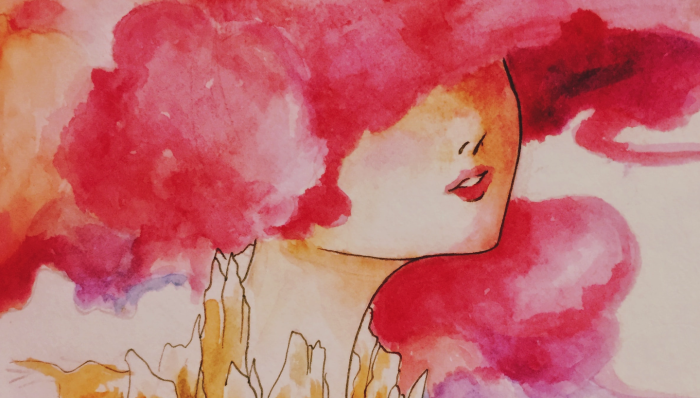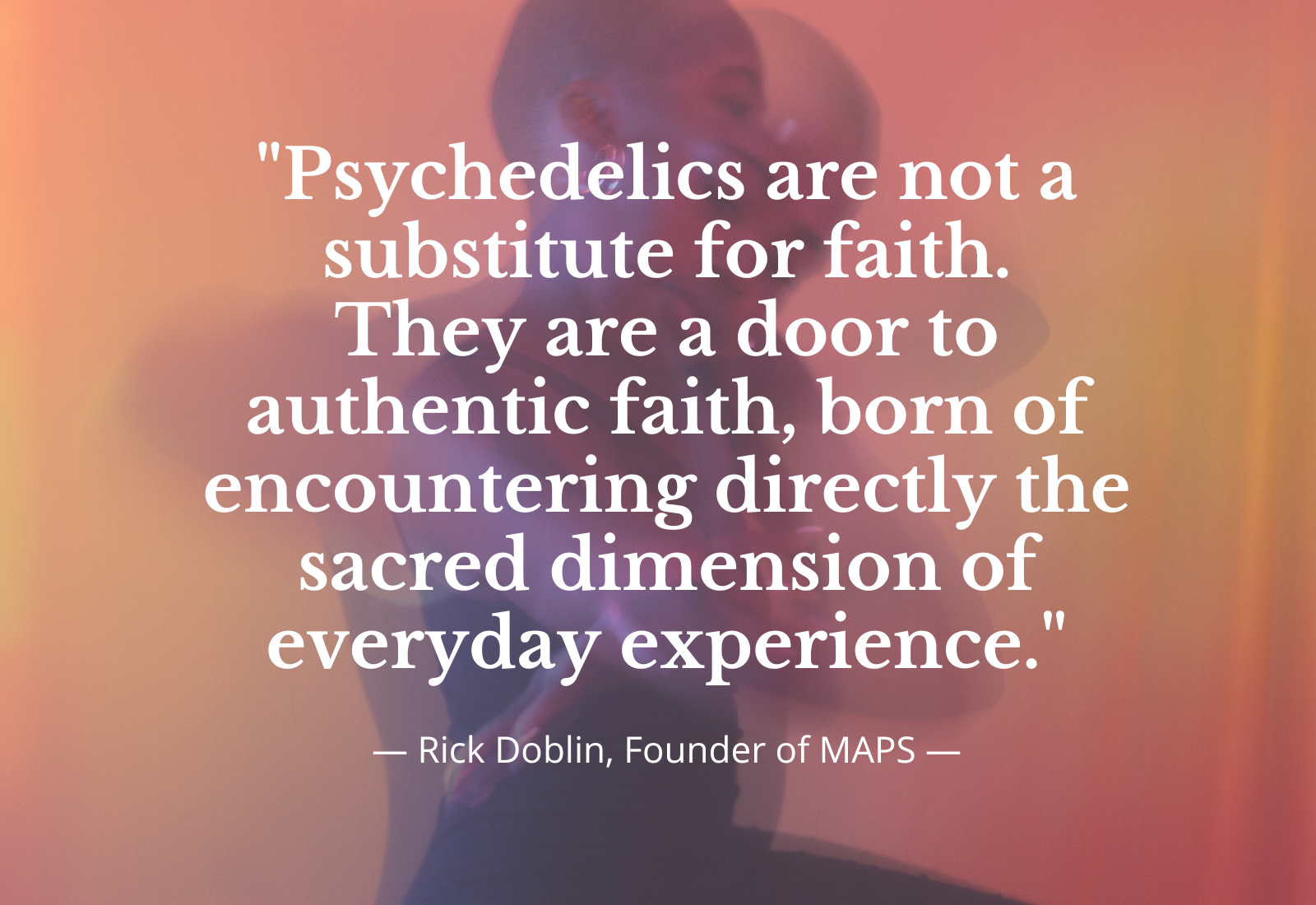This post is written in partnership with Naropa University, the birthplace of the modern mindfulness movement. They’re challenging mainstream higher education by inviting the whole student—mind, body, and spirit—to show up in the classroom, and we’re honored to work with them.
~
There’s a Buddhist way to “do” psychedelics—and do it ethically.
Yes, psychedelics.
As in MDMA, psilocybin, ketamine, and the likes.
If you’re thinking the B word and LSD don’t seem like they mix, you’d be in good company with many other skeptical Buddhists wondering what exactly meditation and MDMA have in common.
And yet here we are, in 2023, and one of the most reputable Buddhist-inspired educational facilities, Naropa University, is establishing itself as the premier academic institution in Psychedelic-Assisted Therapies (PAT) training and education.
Yep. Buddhists, chaplains and mindfulness practitioners are leading the ethical, equitable, and responsible psychedelic revolution with their prayer flags held…well, high.
Don’t worry; ketamine can be legally administered for therapeutic use, and the FDA has given MDMA and psilocybin breakthrough status, which is awarded when results are so promising that a substance’s legalized use is somewhat expedited.
But as the conversion of psychedelics from hippy-esque recreational substances to medicinal superheroes continues, the conversation about how to ensure their ethical use grows more poignant. And Naropa has a way for all of us to join in on that chatter—whether we’re:
>> The everyday person curious about ketamine or MDMA
>> An experienced mushroom or LSD afficionado
>> A professional searching for a unique training program to help us approach psychedelic therapies ultra-ethically.
Learn the Buddhist Approach to Psychedelic-Assisted Therapies >>
Woo-hoo! Psychedelics for everyone! Well, kinda.
So, you wanna take some heroic doses of MDMA, have some rad experiences, and tap into some perspective-changing power? That’s cool, but hold up a sec.
Dr. Sara Lewis is Associate Professor of Contemplative Psychotherapy and Buddhist Psychology at Naropa University, where she also serves as Director of Training & Research for the Naropa Center for Psychedelic Studies. Additionally, she is a psychotherapist in private practice and has conducted research on how psychedelics can be a catalyst for change, and she explains psychedelic use somethin’ like this (we’re paraphrasing):
There are 84,000 Buddhist teachings and just as many different minds. A Vipassana retreat is not for everyone, nor is a Tibetan Buddhist Tantra practice. Psychedelic use is the same.
Basically, while “the meaning that we impute onto drugs is completely political,” Lewis says, “there are clear risks. Psychedelics are not for everyone at every time in their life,” and hesitancy on the part of some individuals is both healthy and wise (1).
Still, we don’t all need to say “nope to dope.” Psychedelic drug use (especially in a clinical setting) isn’t as sketchy as many of us may have been conditioned to believe. In some cases, the healing benefits of their use can be phenomenal—particularly in regard to PTSD.
But even when it comes to receiving standard medicinal treatments for PTSD, one study of veterans with the disorder found that there is a racial hierarchy in the prescription of pharmacotherapy for PTSD patients (2).
Latino veterans were less likely to receive pharmacotherapy than White veterans, and African American veterans were the least likely to receive any treatment at all in the 6 months post diagnosis (2).
That’s particularly shocking when we consider the fact that in the 1950s and 1960s, under a project labeled MK Ultra, the CIA studied the effects of LSD and other mind-altering drugs to test their efficacy as agents of mind-control and psychological torture in over a hundred experiments—primarily on Black, racialized, incarcerated, and institutionalized men (2).
That’s why Naropa University’s Psychedelic Alchemy Speaker Series (for everyday peeps) and online plus retreat-style PAT Certificate program (for the pros) focus on mindfulness, equity, indigenous reciprocity, and ethics.
Naropa’s talks and certificate program ain’t no casual Burning Man approach; they’re more like informational deep-dives into the psychedelic and plant medicine rabbit hole that hold space for conversations that can expand into making meaningful, positive change.
We’re talking discussions that explore LSD and the Alchemy of Modernity, Buddhism and Plant-Based Medicine in diverse communities, and How the Psychedelic Renaissance Can Stop War. And that’s just for us everyday folk to listen in on.
So, what if we’re someone who has some sticky mental health woes? Maybe we’ve sampled some shrooms, were intrigued by the experience, and are curious about PAT as a means to deepen our healing.
Or maybe we’re a practicing therapist, chaplain, or ecopsychologist (yep, that’s a thing if you didn’t know) looking to add PAT techniques to our toolbox.
How exactly does an assisted therapy approach differ from engaging in these practices without a therapy setting?
Psychedelics from the “couch” (a.k.a. psychedelic therapies)
Well, in the words of Lewis, both mindful recreational psychedelic use and PAT have therapeutic potential. But, “at the same time, the kind of models that have been developed for psychedelic-assisted therapy really create a container of safety.”
And with a real sense of safety, the journey gets real deep, real meaningful, real fast.
At a festival, concert, or just being with friends, the container of our experience is somewhat open. And if it’s open, there’s an ability for unpleasant people, influences, or elements to filter in (1). If we’re in a container where it isn’t safe to let go, we don’t, and the medicinal effect of a psychedelic is reduced, completely diminished, or, in some cases, can even end up being harmful and/or scary .
In a therapeutic context, though, Lewis says, a container is created that allows for real healing to begin.
Learn to Create a Container for Healing through Naropa’s Psychedelic-Assisted Training Program>>
“I might venture to say that the number one most important thing in psychedelic therapy is being able to actually let go,” Lewis says. “The therapeutic context really creates a kind of special opportunity where it is actually safe for people to begin to let go.”
Okay, but I’m Spiritual. Is there really a deeper way to approach doin’ or dolin’ out psychedelic-induced letting go?
I get it. I mean, if psychedelics take us “elsewhere” in our minds when Buddhism is often so focused on presence in and acceptance of the moment, how do drugs that chemically and could perhaps structurally alter our brains (3) come together?
Here’s one way to look at it:
“As a Buddhist, I might say that drugs are empty of inherent nature,” Lewis says. “It’s the meaning we’re imputing onto them that matters.” And when it comes to imputing meaning onto psychedelics, when used as a healing tool, they can be phenomenally beneficial in helping us to do one thing that Buddhists always seek to do—push beyond our ego.
That’s because psychedelics help us to enter deeper layers of our brains and start forming new neurological pathways to healing (4).
That sort of “going beyond” is pivotal to experiencing the real, life-changing results that PAT can offer those who have experienced serious trauma, and it can sometimes be painful or frightening for folks lying on the therapeutic couch.
Help Create Opportunities for Life-Changing Results for those with Serious Trauma >>
Because it gets deep beneath the surface of “who we are,” PAT is ideal for people who have tried almost every other therapeutic avenue to no avail—folks like veterans, first responders, sexual assault survivors, people who have already been through years and years of therapy and different kinds of medications, people with substance abuse, and people who have had suicide attempts.
Yes, you read that right. Psychedelics can actually help folks let go of their addictions rather than create a new one—if administered expertly.
Because of this, PAT is considered by Naropa to be an advanced treatment methodology that requires unique skillsets and knowledge to help guide patients through what might be anything from beautifully moving to vividly ugly experiences. And that’s what they’re here to teach.
And so, a Buddhist-inspired approach to PAT involves taking an approach that differs somewhat from Western medicine, culture, and education.
In Eastern cultures, “most healing happens in families, communities, and ceremony—through ritual, you know—like, really being in the collective,” Lewis says. So as most University programs might conduct studies on the efficacy and safety of psychedelic medicines, Naropa’s PAT program focuses less on those and more on the skills that people need to actually train in to provide high-quality, ethical, and helpful therapy (1).
That means using a hybrid experiential retreat and online learning platform to thoroughly educate physicians, therapists and chaplains to work through a thorough client screening process before administering psychedelic therapeutics and to thus practice ethically as the journey unfolds.
“We need to keep in mind, moment to moment, our motivation for doing this. It is exciting to work in psychedelics. It’s creative; it’s innovating. But you know, ultimately, our motivation should really be to help and to be of benefit,” Lewis says.
Being the guiding light (a.k.a. psychedelic chaplaincy)
If there’s any time we can be of benefit to others or others can be of benefit to us, it is in times of crisis, loss, or as we near death.
Those are the times when chaplaincy and psychedelics intertwine, according to Assistant Faculty and the Director of the Center for Contemplative Chaplaincy at Naropa University, Jamie Beachy.
Learn how to be someone’s guiding light with Psychedelic-Assisted Therapy training >>
If you’ve ever watched someone you love (human or pet) slip out of their body, you know that the experience can feel, at times surreal, and all the existential questions that can arise from that sort of loss.
Chaplains are trained to be present to people in crisis—when there’s distress, an emotional struggle, or loss. They’re there when we’re looking for healing from past or currently unfolding traumas. In that way, chaplains and psychedelics share a thread.
“For psychedelic chaplaincy, the experience of using psychedelics is meant to address trauma, physical illness, the desire to have a transcendent experience, or to connect with something beyond ourselves and find our place in the world as a person of the earth in a good way,” Beachy says. “All of those motivations, I think, are very similar to what chaplains do in our work.”
Beachy says that, often, those same moments of existential awareness we experience in trauma or nearing death can come through in a psychedelic journey. And in both cases, it’s important to integrate to make the journey a psychologically positive experience (5).
Psychedelic journeys are creative spaces and can be challenging (hello, bad trips). Chaplains come into play to enrich the experience. That’s why Naropa’s PAT program is a natural fit for chaplaincy: a lot of the base training crosses over well into psychedelic therapies—in particular, the ability to help assess the spiritual and religious landscape for a person before they go into a psychedelic experience.
Help Guide people through their Psychedelic-Assisted Therapy journeys >>
Because chaplains excel at navigating existential questions as they’re unfolding, they can help those of us on our psychedelic journeys to call on the help of beloved spirits (like a grandmother who’s passed) or other spiritual support in moments of difficult processing.
“Honoring the inner healing intelligence of each person is the goal of chaplaincy,” Beachy says. And that’s what plant medicine and psychedelics tend to do.
Naropa’s PAT program takes on some of the deeper existential questions we might run into while experiencing or guiding someone through a therapeutic psychedelic journey, and explores the skills needed to successfully assist folks in navigating through, from a more spiritual than psychological standpoint.
Planting change with sustainable, er, trips into nature (a.k.a. ecopsychedelics)
Dr. Travis Cox, Core Associate Professor in the Ecopsychology Department at Naropa University, is particularly interested in how plant medicine could alter the minds of the world in a way that might encourage more connection with and care for our planet.
The theory is that since psychedelics can reconfigure our brains to soften around the calcified patterns we have, like addiction and depression, taking and using psychedelics in certain environments could help us soften our calcified worldviews and connect more strongly with the earth (6).
“That’s exactly what we have to do in terms of sustainability,” Cox says of disabling our short-circuiting psychological wiring. “I think it’s more than synchronistic that there’s this resurgence of psychedelics at the same time that we need to take drastic action to save the planet.”
Inspire people to Recognize our Connection to each other & Every Living “Being.” >>
It might seem pretty far out there, but those of us who are active or who enjoy the outdoors to any extent can attest to the power of nature to really bring us back to center when we’re feeling out of whack. Cox’s argument is that if we were to expose more people stuck in urban environments to nature, and perhaps enhance the experience with psychedelics and plant medicine, the connection could be deep enough to inspire folks to recognize our inextricable connection—to each other and every other living “being.”
“Part of ecopsychology and psychedelics to me is just this recognition that our planet is filled with innumerable, like beyond trillions of beings that are alive and have some form of awareness,” Cox says. “And psychedelics really tap you into that.”
But another aspect of ecopsychology that wraps like a vine into the realm of therapeutic psychedelics is the focus on sustainability. We might be hard-pressed to talk to someone who doesn’t wonder how much is too much, or who doesn’t have concerns about what happens when we start to introduce psychedelics into mainstream society. And in that case, Cox is quick to point out that not even the earth-based cultures that have psychedelics in their culture use them regularly; they use them in ceremonial or ritualistic ways—like a reset (6).
Still, even intermittent use of psychedelics could make a big impact, Cox believes. “The dominant, colonialist, let’s say patriarchal, white supremacist, and militaristic society is problematized by the fact that if you take these substances, start asking these questions,” Cox says.
Take the Mindful Route to Psychedelic-Assisted Therapies >>
If you’re enthusiastic about restorative justice and into psychedelics, you might enjoy this suggestion of Cox’s: in one example of the application of psychedelics to ecopsychology, he mentions the idea of doing a little MDMA in restorative justice practices.
MDMA, Cox says, was synthesized by Alexander Shulgin and, before it became a club drug, people were using it in low doses for marriage therapy because it allows for compassion and openness.
So, then, imagine taking a low dose of MDMA when you’re with nature instead of with a person.
“You’ll be able to have a more reciprocal relationship to the natural world,” says Cox. “It’s just like learning to see it and then choosing to consciously have a relationship to it.”
Like talking to a tree while you’re going on a walk and not caring if people think you’re crazy. (Yep, been there, done that—without the psychedelics).
So, speaking of trees and earth, when we start to really dig into it, there are seemingly limitless ways that we can tap into the healing power of psychedelics in a mindful and meaningful way; the possible Buddhist application of psychedelics is not limited to these three practices by any means.
But there are precautions that we must take both if we intend to use psychedelics recreationally (keep it on the down low, obviously) or if we are professionals yearning to tap into plant power to enhance healing and restorative efforts.
Regardless of the purpose, Naropa University has the tools and resources that we need to help us be sure to keep ethics at the top of our minds as we enter into our own perspective journeys.
As Lewis says, “if you’re someone who’s really interested and ready to understand your own positionality, your own social locations, and why that’s actually important to become an ethical, psychedelic-assisted therapist,” Naropa might be right for you.
Curious, Mental Health Practitioner? Look into Enrollment Today >>
~
Resources
1. https://naropablog.com/2021/09/29/dr-sara-lewis-psychedelic-assisted-therapy/
2. https://www.ncbi.nlm.nih.gov/pmc/articles/PMC8811257/#B15
3. https://pubmed.ncbi.nlm.nih.gov/25637267/
4. https://neo.life/2020/10/inside-the-movement-to-decolonize-psychedelic-pharma/
5. https://naropablog.com/2021/09/28/jamie-beachy-psychedelic-chaplaincy/
6. https://naropablog.com/2022/03/03/travis-cox-ecopsychology-and-psychedelics/
 Share on bsky
Share on bsky







Read 9 comments and reply